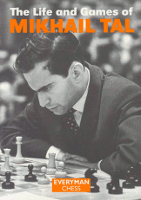The Games of Mikhail Tal
by Michael McGuerty
Mikhail Tal: 8th World Champion by ChessOK, Figurine Algebraic Notation, Download, $25.00 (ChessCafe Price $21.17)
Mikhail Tal: 8th World Champion is a downloadable course designed for the free Peshka graphical interface. It is described by the publisher as follows:
“The most complete collection of Tal’s games ever compiled. Contains 2,592 games, covering the entire career of the most brilliant attacking chessplayer in history. All the games thoroughly annotated by GMs Khalifman, Kochiev, Makarichev, Sveshnikov, Yudasin, and Petersburg IMs. Plus 260 carefully chosen quiz positions on the basis of both strong and beautiful moves played by Tal in his games in a special additional section, ‘Play As Tal’.”
Before you purchase any Peshka course, you should first download and install the Peshka program. Peshka runs on Windows operating systems, from Windows XP up to Windows 8. It comes preloaded with the free training course, Play Like Botvinnik, and this offers you a great opportunity to become familiar with the program’s quirks before committing to a specific course. (Many previous reviews have discussed how to best use the Peshka program and these can be found in the ChessCafe.com Archives-ed.)
Once you are ready to explore other courses, you can read the installation guide for step-by-step instructions to access your new course. You may also wish to download the user manual.
Upon launching the course, the Navigator window, while in Theory mode, shows that the content is assembled chronologically:

If you double-click on Volume 1, and switch to the Notation tab, then the list of games within that section become available:

There are 100 games in this section, and these can be accessed by clicking the Task buttons at the top of the screen. However, there is no search feature to find specific games and there is no game heading information to find specific opponents. The names of the opponents and the results of the games are given at the end of each game:

Note, too, the inclusion of a text diagram within the game score to highlight the position:

My assumption is that this reflects the placement of a diagram from a book; perhaps the Chess Stars publications Mikhail Tal’s Games Vols. 1-3. Anyway, these extra diagrams serve to indicate interesting positions or critical moments.
Play from the diagram continued as follows: 19.Rf6! Qf8 [19…gxf6 20.exf6 Nxf6 21.Qxh6 Ne4 22.Bxe4 dxe4 23.Ng4; 19…Nxf6 20.exf6 gxf6 21.Qxh6 f5 22.Ng4!] 20.Rf4 Bd7 [20…Qe8 with the idea 21…f5 21.Bxh7 Kxh7 22.Qf3 with the idea 23.Rf1, 24.Ng4 with an attack] 21.Ng4 Be8 22.Nf6 Nxf6 23.exf6 Rc7 [23…gxf6 24.Rxf6 with the idea 25.Rh6] 24.fxg7 Kxg7 [24…Qxg7 25.Rg4] 25.Qe5 1-0, Tal Mikhail (LAT) – Leonov A (RUS), Vilnius 1.1.1949.
The game annotations are Informant-style, language-less variations, often with more modern branch games included in the notes:

Overall, the annotations are quite extensive through every phase of the game, with snippets of analysis quoted from a wide variety of sources. The very first game in the collection is Tal-Leonov, Vilnius 1949 and the very last is Tal-Akopian, Barcelona 1992. There are seven Tal games from 1949, while a search through the ChessBase Megabase only turns up five; yet, interestingly, the only game in common between the two is the one against Leonov.
To access the quiz positions, just click the Practice button at the bottom of the Navigator window:

Here you can solve the exercises and the program keeps track of your results. Again, to work through each position, click the Task button at the top of the screen. The chess board indicates which side is to move, and you move a piece on the screen to try to solve the puzzle. If you guess incorrectly a hint will appear or the program will move the piece for you after a number of incorrect guesses. At a certain point in the puzzle, the program may play out all the remaining game moves once you have solved the critical tasks. Once a task is completed, a pop-up appears prompting you to open the next task, and the task bar turns green for that entry. Test mode is similar to Practice mode, though there are many choices for determining which material is included.
There are a number of configurable options within the Peshka interface. The main screen layout can be altered. The speed with which the pieces move can be adjusted, the engine time can be tweaked for playing against the built-in chess engine, and the print options can be changed. There is also an export to Aquarium button that sends the loaded game to the Aquarium software program if it is installed on your system.
Even though the Peshka interface has its shortcomings, Mikhail Tal: 8th World Champion is a bargain when you consider how many annotated games you get and the comparative cost if this were published on paper. Other courses in the series are Alexander Alekhine: 4th World Champion, Boris Spassky: 10th World Champion, Bobby Fischer: 11th World Champion, and Garry Kasparov: 13th World Champion.
My assessment of this product: ![]()
Order Mikhail Tal: 8th World Champion
by ChessOK
© 2014 ChessEdu.org. All Rights Reserved.




Leave a Reply